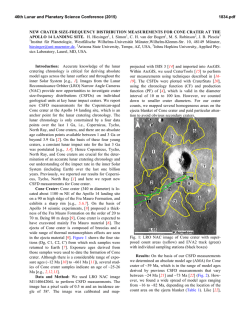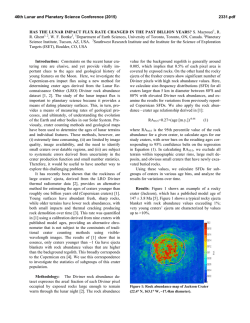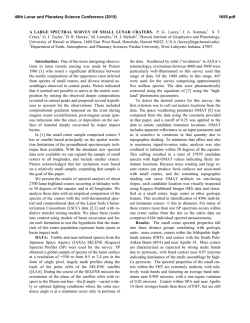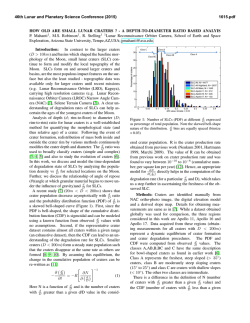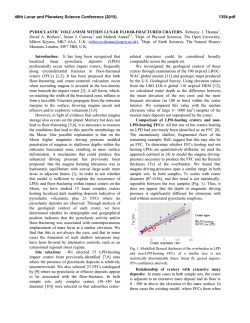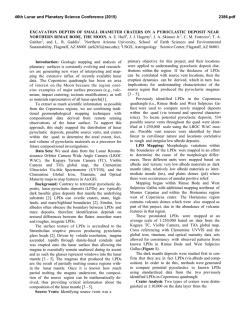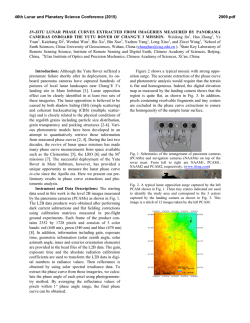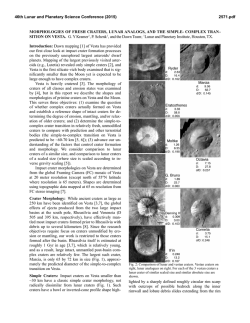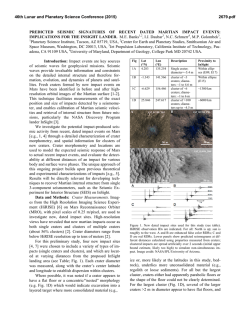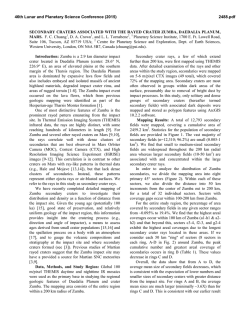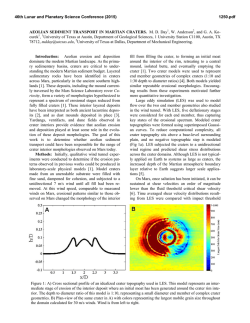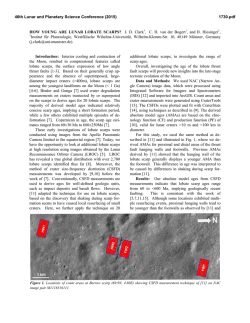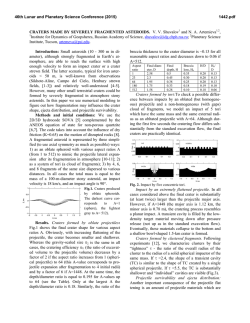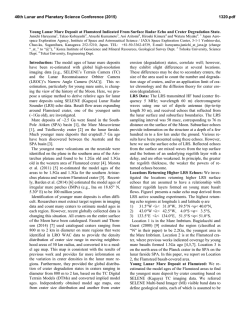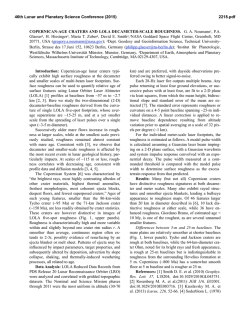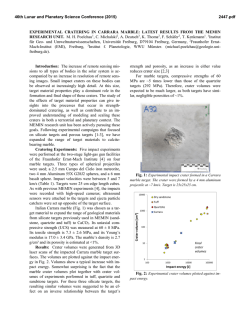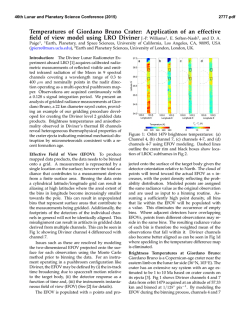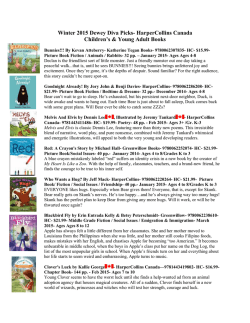
Effects of Count Area Size on Absolute Model Ages Derived from
46th Lunar and Planetary Science Conference (2015) 1742.pdf EFFECTS OF COUNT AREA SIZE ON ABSOLUTE MODEL AGES DERIVED FROM RANDOM CRATER SIZE-FREQUENCY DISTRIBUTIONS. C. H. van der Bogert1, G. Michael2, T. Kneissl2, H. Hiesinger1, and J. H. Pasckert1, 1Institut für Planetologie, Westfälische Wilhelms-Universität, Wilhelm-Klemm-Str. 10, 48149 Münster, Germany ([email protected]), 2Freie Universität Berlin, Malteserstr. 74-100, 12249 Berlin, Germany. Introduction and Background: The accuracy and precision of absolute model ages (AMAs) derived from crater size-frequency distributions (CSFDs) are important for our ability to interpret the geological evolution of planetary surfaces, as well as the thermal evolution of planets. Factors that affect the quality of model ages include the careful selection of appropriate counting areas, consistent and accurate measurement of crater diameters, as well as the statistical significance of the dataset – the number of craters measured [1-3]. As higher resolution imagery becomes available for different planetary surfaces, such as LROC NAC imagery of the Moon [4], smaller regions can be investigated. However, these areas contain fewer craters for CSFD analysis. For example, a study of irregular mare patches (IMPs) [5] was only able to measure craters that were large enough for derivation of AMAs, using the current lunar chronology and production functions (valid for craters 10m<D<100km [6]), at three IMPs: Cauchy-5 with a 1.3 km2 count area giving an AMA of 58±4 Ma, Ina with a 1.7 km2 count area is 33±2 Ma, and Sosigenes with a 4.5 km2 count area is 18±1 Ma. The robustness of the derived ages is critical for the implications of such young volcanism on the Moon. In addition, count areas for important young craters (e.g., North Ray [7] and Cone [8] craters), which are used to define the lunar chronology are also relatively small, with areas of less than 1 km2. While, Hiesinger et al. [7] show that ages derived from small areas and sums of small areas are consistent with ages of larger areas counted using lower resolution WAC data, the ages derived from small count areas exhibit variability larger than the statistical error bars [7,8]. As a result, Pasckert et al. [9] investigated the ability of 4 km2 count areas to reproduce the age of a 100 km2 count area by measuring a mare basalt in Tsiolkovsky crater. The 100 km² area is 3.19+0.08-0.12 Ga, while the ages of the 25 4 km² areas show AMAs between 2.22+0.55-0.57 and 3.69+0.10-0.44 Ga, with an average of 3.2 Ga and standard deviation of 0.33 Ga [9]. While 19 of the ages are within the error bars, six of the ages fall outside of the error: four higher and two lower. The younger ages could reflect resurfacing events associated with later volcanism or relatively larger impact craters that caused local resurfacing detectable in the CSFDs [9]. Approach: To eliminate the effects of local geological activity and investigate just the effects of differing count area sizes, we generated random crater distributions for theoretical lunar surfaces with ages of 0.1, 1, 2, 3, 3.5, and 4 Ga. Here, we present initial results from analysis of 0.1 and 4 Ga old surfaces. Figure 1. Absolute model ages derived from a random distribution of craters generated with the lunar chronology and production functions of [6] for a theoretical lunar surface with an age of 100 Ma. Figure 2. Absolute model ages derived for a theoretical lunar surface with an age of 4 Ga. Note the expanded age scale; the percent errors in this age range are less than in Fig. 1. 46th Lunar and Planetary Science Conference (2015) Methods: CSFDs were generated for theoretical lunar surfaces with differing ages based on the production and chronology functions (PF, CF) of [6] using a Monte Carlo method. For a chosen minimum crater diameter, Poisson event intervals are generated from the CF until the required cumulative time is achieved. Crater diameters are drawn from the PF, with the craters being emplaced homogeneously and randomly within the areas. These were converted into shapefiles for analysis with ArcGIS, where count areas of differing sizes were defined and resulting CSFDs (using fractional craters) exported using CraterTools [10]. The CSFDs were plotted and fit with CraterStats [2], using the techniques described in [1, 2]. The derived AMAs are based on the CF and PF of [6], valid for lunar craters with 10m<D<100km. All CSFDs were checked for clustering/ordering [2] to confirm the distributions were in fact random. Results: 0.1 Ga Surface. For a random distribution of craters with D>50m across a 2500 km2 area on a theoretical lunar surface with an age of 0.1 Ga, we derive an AMA of 102+1.3-1.2 Ma (Fig. 1, black circles/line). For the 25 100 km2 subareas, the ages range from 92.5±5.7 to 114±6.8 Ma, with an average of 103.3±6.2 and a standard deviation of 5.4 Ma. Most of the statistical error bars for the derived AMAs are within error of the theoretical 100 Ma age. However, 8 of the 25 measurements have statistical errors that do not include the 100 Ma value (Fig. 1, blue squares). For 25 4 km2 areas, AMAs range from 230±52 to 41.9±17 Ma, with an average of 109.3±32 and a standard deviation of 43.4 Ma (Fig. 1, red diamonds). Again, 8 of the 25 areas have values that do not exhibit the expected 100 Ma age, even within their error bars. 4.0 Ga Surface. For a random distribution of craters with D>500m across a 2500 km2 area on a theoretical lunar surface with an age of 4 Ga, we derive an AMA of 3.99 Ga (Fig. 2, black circles/line). For the 25 100 km2 subareas, the ages range from 4.05±0.01 to 3.95±0.02 Ga, with an average of 3.99±0.02 Ga and a standard deviation of 0.03 Ga. For most of the AMAs, the statistical error bars are not within error of the theoretical 4 Ga age. However, the values are not highly inaccurate, because their average still yields a value consistent with the theoretical surface and their percent errors are <2% (Fig. 2, blue squares). For 25 4 km2 areas, AMAs range from 4.19+0.04-0.06 to 3.61+0.090.25 Ga, with an average of 4.00+0.06-0.23 and a standard deviation of 0.12 Ga (Fig. 2, red diamonds). However, the subarea with the youngest age has very poor precision because it contains only a fraction of a crater. Excluding this data point, gives an average of 4.02+0.06-0.10 and a standard deviation of 0.09 Ga. The error bars of 13 of the AMAs do not include the 1742.pdf theoretical surface age, however, this is likely because all the fits are to 10 and fewer craters, thus giving poor statistics. Again, the average of all the areas gives a value consistent with the overall age with percent errors typically <5%. Discussion: The precision of the model age (error bars) is determined by the Poisson cratering process and the non-linearity of the CF for the crater measurements themselves, including the number of craters used to generate the fit [e.g., 2]. Smaller count areas have fewer craters, such that this statistical precision decreases. However, our study shows in addition that the accuracy of the AMAs is affected by the size of the count area – the accuracy decreases for smaller count areas. This means that it may be possible to select a count area that does not give a representative age, even when the distribution of craters is random. This effect cannot be mitigated by the usual approaches for selecting ideal count areas, except to increase the size of the area, which may be impossible for small features. The percent errors for younger surfaces are significantly greater than for older surfaces. Young surfaces may have 50-100% percent errors (Fig. 1), while old surfaces have percent errors typically <5% (Fig. 2). However, even with the inaccuracies we document for young surfaces ca. 100 Ma in age, the ages of the IMPs can still be confidently interpreted to be late Copernican in age. Importantly, the average ages of the small count areas were consistent within error with the theoretical ages of the surfaces, supporting the approach of [7,8], wherein many small count areas are summed. Larger variations in AMAs of small areas on real lunar surfaces are also caused by small-scale geological effects such as volcanism, impact resurfacing, and mass-wasting. These effects will also reduce the accuracy of AMAs derived from small count areas. However, careful mapping when selecting the count area and a solid understanding of the local geology can help reduce these errors, so that AMAs for small areas can provide valuable and useful information about small features (see e.g., [5,7-9]). References: [1] Neukum (1983) Meteoritenbombardement und Datierung planetarer Oberflächen, Habil. Thesis, Univ. Munich, 186pp. [2] Michael and Neukum (2010) Earth Planet. Sci. Lett. 294, 223. [3] Crater Analysis Working Group (1979) Icarus 37, 467-474. [4] Robinson et al. (2010) Space Sci. Rev. 150, 81. [5] Braden et al. (2014) Nature Geosci. 10.1038/NGEO2252. [6] Neukum et al. (2001) Space Sci. Rev. 96, 55. [7] Hiesinger et al. (2012) JGR 117, E00H10. [8] Hiesinger et al. (2015) LPSC 46, 1834. [9] Pasckert et al. (2015) Icarus, in review. [10] Kneissl et al. (2011) Planet. Space Sci. 59, 1243.
© Copyright 2025
